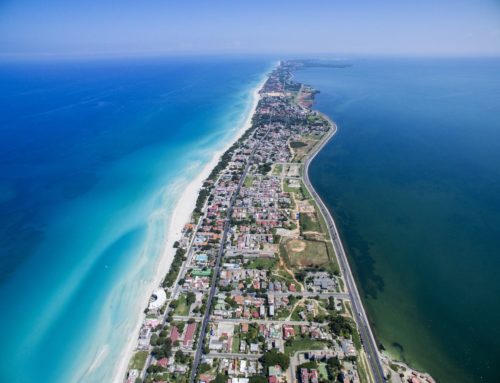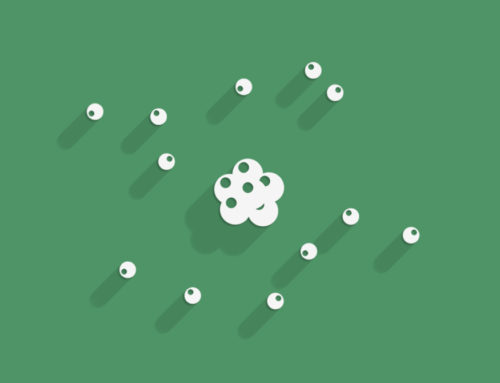Ecological Self-Organization
The flocking formation of birds is an example of self-organization
Self-organization is a process in which patterns at the global level of a system emerge solely from numerous interactions among the lower-level components of the system. The rules specifying interactions among the system’s components are executed using only local information, without reference to the global pattern.1 This pattern formation in biological systems can derive from the interactions among components that are potentially very simple, even when extremely sophisticated patterns are built, such as the complex nests of termites, the coordinated movements of birds in a flock, or even human consciousness. Out of a network of nonlinear interactions between simple components, self-organization can give rise to complex phenomena on the macro-level which then in turn feedback to both enable and constrain the components on the local level.
Organization
The theory of self-organization helps us to approach one of the big questions within biology and ecology, that of organization and order, how and why do we get this extraordinary level of organization we see within ecosystems? The Second Law of Thermodynamics tells us that the disorder or entropy of a physical or chemical system and its surroundings must increase with time. In other words, systems left to themselves must become increasingly random, the ordered energy of a system must degrade eventually to this randomness. But there are many instances in which physical systems spontaneously create emergent patterns of order. For example, despite the destruction they cause, hurricanes have a very orderly vortex motion when compared to the random motion of the air molecules in a closed environment. Even more spectacular is the order created by chemical systems; the most dramatic being the order associated with life.
Open Systems
The Second Law only tells us about closed systems, what we are dealing with in ecology though are in fact open systems. If the system has a high enough exchange with its environment order can be created in the system by an even greater decrease in the order of the system’s surroundings. In the hurricane example, hurricanes are formed from unequal heating within the atmosphere. The Earth’s atmosphere is then far from thermal equilibrium. The order of the Earth’s atmosphere increases, but at the expense of the order of the sun. The sun is becoming more disorderly as it ages and throws off light and material to the rest of the universe. The total disorder of the sun and the earth increases despite the fact that orderly hurricanes are generated on earth.
Dissipative Systems
Shoal of Mackerel Fish. Fish shoals are created out of a relatively simple set of rules governing the behavior of the individual fish
Dissipative systems, such as the Bénard cells created by boiling water, can exhibit dynamic self-organization. Such structures are necessarily open systems: energy and/or matter are flowing through them. The system is continuously generating entropy, but this entropy is actively dissipated, or exported, out of the system.2 Thus, it manages to increase its own organization at the expense of the order in the environment. The system circumvents the Second Law of Thermodynamics simply by getting rid of excess entropy. Plants and animals take in energy and matter in a low entropy form as light or food. They export it back in a high entropy form, as waste products. This allows them to reduce their internal entropy, thus counteracting the degradation implied by the Second Law. It is this dissipative catabolic process within ecosystems that constantly produces disorder in the form of exported low-grade heat that paradoxically makes possible the maintenance of order in the system through self-organization.
Constructal Law
It is this feature to dissipative systems like ecologies that creates the condition for self-organization, where we can think of a dissipative system as a context wherein energy is imported and entropy is explored, given that context elements within the system will then self-organize to process whatever resource is flowing through the system. This is part of the essence of biological creatures, not only are biological systems dissipative but also they perform some internal function, all biological creatures process energy and matter in some form, and elements internal to the system have to self-organize to do that.3 That is to say, biological creatures somehow have evolved orderly internal structures that enable their functionality and this internal functionality to biological entities has no equivalent within inert physical systems. This can be understood with reference to the maximum power principle and constructal law. Where during self-organization, the system designs develop and prevail that maximize power intake, energy transformation, and those uses that reinforce production and efficiency. Or according to the constructal law, for a flow system to persist in time it must evolve freely such that it provides greater access to its currents.4 Thus where the Second Law commands that things should flow from a higher to lower energy potential, the constructal law posits that they evolve in configurations that flow more and more easily over time and the elements in the system self-organize to achieve this, in so doing producing some macro-level pattern of organization.5 We can ask then why do all the different parts of an ecosystem appear to fit together so well? What is responsible for organizing all the parts, their functional connections and resulting feedback loops, in a way that allows everything to function together? The amazing answer is that ecosystems organize themselves. Because the ecosystem is a dissipative system inside of which is available free energy, this exergy can be used to create some form of order and functionality through the process of self-organization.6
Process
self-organizing, emergent properties form the striped patterns on a zebra’s coat
Today this process of self-organization is understood to take place through a number of key stages. The dynamics of a self-organizing system is typically non-linear, because of circular or feedback relations between the components. This involves some form of initial randomness or fluctuation, the presence of positive feedback loops that can then amplify these small events, when this positive feedback reaches its limit it dies out creating negative feedback with closed attractors forming and finally out of all of this we get the emerges of some global pattern. Non-linear systems have in general several stable states, and this number tends to increase or bifurcate as an increasing input of energy pushes the system further from its thermodynamic equilibrium. The basic dynamics underlying self-organization is one of variation which explores different regions in the system’s state space until it enters an attractor. This precludes further variation outside the attractor, and thus restricts the freedom of the system’s components. This is equivalent to the increase of order, or decrease of statistical entropy, that defines self-organization.7
Fluctuations
Many theories surrounding self-organization involve an initial state of randomness within which fluctuations or noise can take hold. For example, Prigogine proposed the principle of “order through fluctuations”. This may be understood with reference to a simple observation that if the components in the system are already held within some global form of organization this will likely resist alteration. When an ecosystem, organism or some other system is held in an orderly strong basin of attraction it is difficult for small events to take hold through self-organization, we need some initial state of entropy and randomness for this process to take hold.
Positive Feedback
Some small fluctuation can only really take hold given positive feedback, positive feedback can take hold around some small event and by compounding on its presence with every iteration work to amplify it into a large systemic effect. One example of this would be the process whereby bees form swarm attacks against an enemy. When a potential enemy is identified the bee may attack but the bee also releases a pheromone communicating to others to do likewise, thus for every new bee that attacks we get a stronger accumulation of pheromones placing an even greater attraction on other bees to join. This is an example of a positive feedback process synchronizing the states of the bees as they come to form a swarm around the enemy. Similarly, positive feedback through pheromone excretion is present in the formation of patterns within ant colonies.
Another example would be any form of autocatalytic chemical process. A single chemical reaction is said to have undergone autocatalysis if one of the reaction products is also a reactant and therefore a catalyst in the same or a coupled reaction.8 In this way the more reactions we get the more catalysts we will have which then generate more reactions and so one. These are examples of runaway positive feedback that works to cascade through the system aligning all the elements into some coordinated regime.
Phase Transitions
As self-organization is an inherently nonlinear process, the transition to order as the distance from equilibrium increases is not usually continuous. The order typically appears abruptly. The threshold between the disorder of chemical equilibrium and order is known as a phase transition. The conditions for a phase transition can be determined with the mathematics of non-equilibrium thermodynamics.9
Attractor
Iron filings held in a stable attractor by a magnetic field
Once the process of positive feedback has run its course and met some boundary or formed a number of different local attractors, then negative feedback starts to take hold once again creating a stable state. The British cybernetician W. Ross Ashby proposed what he called “the principle of self-organization” noting that a dynamical system, independently of its type or composition, always tends to evolve towards a state of equilibrium, or what would now be called an attractor. This reduces the uncertainty we have about the system’s state, and therefore the system’s statistical entropy. This is equivalent to self-organization. The resulting equilibrium can be interpreted as a state where the different parts of the system are mutually adapted and balanced as they form local attractors closing in on themselves, creating what we would call closure.
Closure
For the outside observer, closure determines a clear distinction between inside and outside, and therefore a boundary separating system from the environment. This boundary can encompass all components of the original system. If the system settles into a negative feedback regime, it will be relatively impervious to external disturbances. The system has now become responsible for its own maintenance and thus become largely independent from the environment. It is thus also “closed” against influences from the outside. Although in general there will still be an exchange of matter and energy between system and environment, the organization is determined largely by its internal dynamics. Thus one may say that the system is at this stage thermodynamically open but organizationally closed.10




























